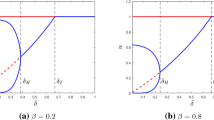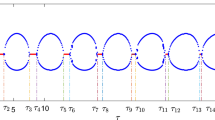Abstract
The effects of demographic and environmental noise on the vital dynamics and spatial pattern formation are studied for a predator–prey system with strong Allee effect in the prey species. Time and space are taken discrete. It is shown that noise can promote extinction depending on the growth and interaction parameters as well as the noise type and amplitude. The extinction risk increases with the noise amplitude; however, the environmental and demographic noise can have different effects on the risk of extinction. In space, the spatial structures obtained are blurred versions of the deterministic ones in most scenarios. In particular, the complex spatial structures that appear in the parameter domains where the deterministic local dynamics leads to extinction are robust to the density-dependent stochastic fluctuations but are disrupted with environmental noise.











Similar content being viewed by others
References
Allen JC, Schaffer WM, Rosko D (1993) Chaos reduces species extinction by amplifying local population noise. Nature 364:229–232
Bashkirtseva I, Ryashko L (2018) Noise-induced shifts in the population model with a weak Allee effect. Phys A 491:28–36
Blomberg C (2006) Fluctuations for good and bad: the role of noise in living systems. Phys Life Rev 3:133–161
Brännström A, Sumpter DJT (2005) Coupled map lattice approximations for spatially explicit individual-based models of ecology. Bull Math Biol 67:663–682
Brännström A, Sumpter DJT (2006) Stochastic analogues of deterministic single-species population models. Theor Popul Biol 69:442–451
Carlos C, Braumann CA (2017) General population growth models with Allee effects in a random environment. Ecol Complex 30:26–33
Comins HN, Hassell MP, May RM (1992) The spatial dynamics of host-parasitoid systems. J Animal Ecol 61:735–748
Courchamp F, Clutton-Brock T, Grenfell B (1999) Inverse density dependence and the Allee effect. Trends Ecol Evol 14:405–410
Courchamp F, Berec L, Gascoigne J (2008) Allee effects in ecology and conservation. Oxford University Press, Oxford
Dennis B, Assas L, Elaydi S, Kwessi E, Livadiotis G (2016) Allee effects and resilience in stochastic populations. Theor Ecol 9:323–335
Dennis B (2002) Allee effects in stochastic populations. Oikos 96:389–401
Dennis B, Taper ML (1994) Density dependence in time series observations of natural populations: estimation and testing. Ecol Monogr 64:205–224
Engen S, Bakke O, Islam A (1998) Demographic and environmental stochasticity—concepts and definitions. Biometrics 54:840–846
Engen S, Lande R, Saether B-E (2003) Demographic stochasticity and Allee effects in populations with two sexes. Ecology 84(9):2378–2386
Goodsman DW, Koch D, Whitehouse C, Evenden M, Cooke B, Lewis MA (2016) Aggregation and a strong Allee effect in a cooperative outbreak insect. Ecol Appl 26(8):2623–2636
Halley JM, Iwasa Y (1998) Extinction rate of a population under both demographic and environmental stochasticity. Theor Popul Biol 53:1–15
Hanski I (1991) Single-species metapopulation dynamics: concepts, models and observations. Biol J Linnean Soc 42:17–38
Hassell MP, Comins HN, May RM (1991) Spatial structure and chaos in insect population dynamics. Nature 353:255–258
Heino M, Sabadell M (2003) Influence of coloured noise on the extinction risk in structured population models. Biol Conserv 110:315–325
Kot M, Lewis MA, van der Driessche P (1996) Dispersal data and the spread of invading organisms. Ecology 77:2027–2042
Kramer AM, Dennis B, Liebhold AM, Drake JM (2009) The evidence for Allee effects. Popul Ecol 51:341–354
Lewis MA, Kareiva P (1993) Allee dynamics and the spread of invading organisms. Theor Popul Biol 43(2):141–158
Malchow H, Hilker FM, Petrovskii SV (2004) Noise and productivity dependence of spatiotemporal pattern formation in a prey-predator system. Discret Continuous Dyn Syst B 4(3):705–711
Malchow H, Petrovskii SV, Medvinsky AB (2001) Pattern formation in models of plankton dynamics. A synthesis. Oceanol Acta 24(5):479–487
Malchow H, Petrovskii S, Venturino E (2008) Spatiotemporal patterns in ecology and epidemiology: theory, models, simulations. Mathematical and computational biology series. Chapman & Hall / CRC Press, Boca Raton
Meinhardt H (1982) Models of biological pattern formation. Academic Press, London
Melbourne BA, Hastings A (2008) Extinction risk depends strongly on factors contributing to stochasticity. Nature 454:100–103
Mistro DC, Rodrigues LAD, Petrovskii S (2012) Spatiotemporal complexity of biological invasion in a space- and time-discrete predator-prey system with the strong Allee effect. Ecol Complex 9:16–32
Morales JM (1999) Viability in a pink environment: why ”white noise” models can be dangerous. Ecol Lett 2:228–232
Morozov A, Petrovskii S, Li B-L (2006) Spatiotemporal complexity of patchy invasion in a predator-prey system with the Allee effect. J Theor Biol 238(1):18–35
Okubo A, Levin SA (2001) Diffusion and ecological problems: modern perspectives, 2nd edn. Springer, New York
Petrovskii SV, Malchow H (1999) A minimal model of pattern formation in a prey–predator system. Math Comput Model 29:49–63
Petrovskii SV, Malchow H (2001) Wave of chaos: New mechanism of pattern formation in spatiotemporal population dynamics. Theor Popul Biol 59:157–174
Petrovskii S, Morozov A, Venturino E (2002) Allee effect makes possible patchy invasion in a predator–prey system. Ecol Lett 5(3):345–352
Ripa J, Lundberg P (1996) Noise colour and the risk of population extinctions. Proc R Soc Lond B 263:1751–1753
Rodrigues LAD, Mistro DC, Petrovskii S (2011) Pattern formation, long-term transients, and the Turing–Hopf bifurcation in a space- and time-discrete predator-prey system. Bull Math Biol 73:1812–1840
Rodrigues LAD, Mistro DC, Petrovskii S (2012) Pattern formation in a space- and time-discrete predator-prey system with strong Allee effect. Theor Ecol 5:341–362
Rodrigues LAD, Varriale MC, Godoy WAC, Mistro DC (2013) Spatiotemporal dynamics of an insect population in response to chemical substances. Ecol Complex 16:51–58
Segel LA, Jackson JL (1972) Dissipative structure: an explanation and an ecological example. J Theor Biol 37:545–559
Stephens PA, Sutherland WJ (1999) Consequences of the Allee effect for behaviour, ecology and conservation. Trends Ecol Evol 14:401405
Stephens PA, Sutherland WJ, Freckleton RP (1999) What is the Allee effect? Oikos 87:185–190
Taylor CM, Hastings A (2005) Allee effects in biological invasions. Ecol Lett 8(8):895–908
Teixeira Alves M, Hilker FM (2017) Hunting cooperation and Allee effects in predators. J Theor Biol 419:13–22
Veit RR, Lewis MA (1996) Dispersal, population growth and the Allee effect: dynamics of the house finch invasion of eastern North America. Am Nat 148(2):255–274
Wang M-H, Kot M (2001) Speeds of invasion in a model with strong or weak Allee effects. Math Biosci 171:83–97
Wang M-H, Kot M, Neubert MG (2002) Integrodifference equations, Allee effects, and invasions. J Math Biol 44:150–168
White SM, White KAJ (2005) Relating coupled map lattices to integro-difference equations: dispersal-driven instabilities in coupled map lattices. J Theor Biol 235:463–475
Wichmann MC, Johst K, Schwager M, Blasius B, Jeltsch F (2005) Extinction risk, coloured noise and scaling of variance. Theor Popul Biol 68:29–40
Acknowledgements
This research was supported by FAPERGS through Edital FAPERGS 012/2013 processes 0414-2551/14-0.
Author information
Authors and Affiliations
Corresponding author
Additional information
Publisher's Note
Springer Nature remains neutral with regard to jurisdictional claims in published maps and institutional affiliations.
Rights and permissions
About this article
Cite this article
Marques, J.C., Malchow, H., Rodrigues, L.A.D. et al. The Effects of Stochasticity on Pattern Formation in a Space- and Time-Discrete Predator–Prey System with Strong Allee Effect in the Prey. Bull Math Biol 81, 1369–1393 (2019). https://doi.org/10.1007/s11538-018-00539-z
Received:
Accepted:
Published:
Issue Date:
DOI: https://doi.org/10.1007/s11538-018-00539-z




